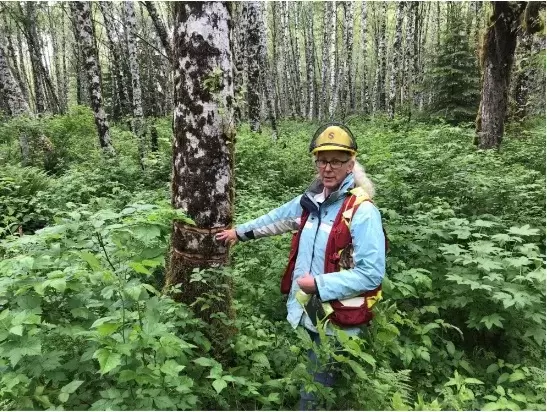Silviculture treatment to rebuild salmon and trout productivity is progressing in a half dozen Nootka Sound streams despite some delay this season due to the pandemic.
Nootka Sound Watershed Society (NSWS) has reached a milestone in a three-year Coastal Restoration Fund (CRF) project designed to bring back an ecological balance lost through logging and roadbuilding.
“This year, Year Two, is a big year for us,” said Kent O’Neill, president of the volunteer-based not-for-profit group. Last year, they received $904,000 in CRF funding for the work.
After the first phase along the Sucwoa River was completed this spring, contractor crews including Mowachaht/Muchalaht First Nation (MMFN) forestry workers conducted riparian prescription along the Tahsis River in June. Crews hired by Nootka Restoration are returning this summer to the Tahsis as well as to the Leiner/Perry and Tsowwin rivers to complete the work. Strategic Natural Resource Consultants, based in Campbell River, is managing the project.
“Because of COVID, it’s taken a while to get going again,” O’Neill said.
The prescription for creating a fish-friendly stream is well understood, but it takes time, lots of time, for nature to do the job. A diversity of trees of all age classes promotes a healthier cycle, replenishing woody debris in the streams that makes them favourable for fish habitat.
Cedar, spruce and fir are planted in riparian zones along the water course. In some cases, these species are missing or growth is stunted by dominance of alder and salmonberry that flourish in the aftermath of logging. Typically, selected mature alder and hemlock are treated by girdling the trunk, removing a ring of bark and tissue around the tree, thereby stopping the flow of water and nutrients to accelerate their decay and open up the forest understory to more sunlight. Cedar seedlings are planted and covered with grow tubes to protect them from browsing ungulates.
“This is a 100-year project,” O’Neill explained. “It’s not something you take lightly when you take that kind of approach. That’s why we have an extensive monitoring program. We’re looking at this as probably a 100-year time frame.”
In the first phase along the Sucwoa River — located between Gold River and Tahsis in Mowachaht/Muchalaht territory — 30 hectares of riparian habitat were treated while 1,200 trees planted, half of them shielded with grow tubes. The trees were donated by Western Forest Products, one of a number of stakeholders contributing to the riparian project.
Tahsis River provides a textbook example of what’s termed “the large woody deficit.” The river banks are unstable and sediment loads are elevated.
How does riparian treatment on shore foster healthier fish habitat in the water? By stabilizing stream banks, preventing erosion and allowing dead trees to fall into the channel. This adds large woody debris to the stream while tree root growth prevents transport of sediments that “pave” the stream bed and smother fish eggs. Through these processes — and over many decades — the whole food chain is enriched: Organic compounds encourage insect and aquatic life; invertebrates that nourish young salmon return.
A third phase of the project shifts to rivers in the Zeballos area this fall, including Chum Creek and Little Zeballos River. The project should be complete by March 2021, O’Neill said.
NSWS is pursuing other grants tackling watershed issues as well as other restoration and enhancement initiatives. One of these involves Gold River, where the winter steelhead run has collapsed.
“It’s an iconic fish on Vancouver Island,” said Roger Dunlop, NTC northern region biologist. “It’s gone. This was Vancouver Island’s premier steelhead stream.”
While the run was declining for a number of years, it has reached rock bottom. Snorkel survey counts revealed one winter steelhead in 2017, three in 2018 and four in 2019. The recreational fishery was finally closed as of 2018. Some, including MMFN, felt it should have been closed sooner. Then, last winter, no fish were counted.
“We’re in early discussions with the provincial and federal governments and developing some kind of strategic plan,” O’Neill said.
The project would go well beyond steelhead, he added. A number of factors are believed to have contributed to low productivity, including recreational overfishing, logging activity, climate change, marine environment and predators. Low summer flows may be limiting steelhead smolt production.
More than 70 potential restoration sites were identified along Gold River in the 1990s, Dunlop noted, so there should be plenty of opportunity for rebuilding fish populations.
Karenn Bailey, stewardship co-ordinator with NSWS, said 19 jobs have been created so far through the riparian project and four First Nation workers underwent training. More workers will be hired and trained as the project advances into the Zeballos area.
The volunteer-based society welcomes donations of time, expertise and cash: https://www.nootkasound.info/.







